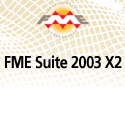

|
|
| ||
GITA: Autodesk Interviewby Adena Schutzberg, from GIS Monitor
Tuesday morning (March 19, 2002) I met with Larry Diamond the Vice President of the GIS Division at Autodesk. Diamond has held a number of positions at Autodesk including in the AutoCAD Group, GIS Group, and Worldwide Engineering. He took over the GIS group when Joe Astroth slid over to head up location services. Diamond reiterated his arguments from the recent Autodesk Investor Day webcast suggesting that now is the time to do more with data. By "do more" he means that data should be used it in more ways: saving money and making money in particular. For opportunities, he used the example of an estimate from the National Association of Civil Engineers that, based on the "D" grade of American infrastructure, it would cost some $1.5 trillion dollars to get roads and bridges up to safe standards. If some 1/100 of that is software, he argued, Autodesk would do quite well. Autodesk's GITA press release on homeland security highlighted two applications built on MapGuide by third party developers. With those products as a starting point, Diamond pointed out that Autodesk is well positioned to participate in infrastructure assessment, remediation and 24/7 monitoring. Emergency response, the fourth segment, as Autodesk views it, is certainly within their realm of possibility, but is not a company focus at this time. The mention of partners, Focus Corporation and FloorView LLC, developed the applications cited in the press release, was a breath of fresh air for me. Autodesk's GIS group, of late especially, has appeared to turn away from developers. I suggested my take on the developer situation to Diamond who noted that in Europe, for example, third party developers account for some 80% of Autodesk Map sales. He notes that is in part due to the product not being localized. The hooks are coming in future releases and that work is to be done in country by partners. Diamond went on to outline the three new "series" coming out. The Civil Series is out. Later this year we'll see the Map Series (Autodesk Map, Raster Design and some new technology) and the OnSite Series (MapGuide, OnSite View, OnSite Enterprise, and some new technology). At least some of the new technology is expected to have some resemblance to the demo provided at Microsoft's Visual Studio.NET rollout and is still under wraps. I think the .NET strategy will reopen the doors for developers. The new series, to my eyes, are a bit of a marketing stunt, but perhaps more of a tease to pull the wary into the subscription program Autodesk has been building. I'll suggest that it's mentally easier to buy into a new payment model when one is buying a "new" product rather than to switch over on an existing product. One more note on subscriptions: I pushed Diamond to the wall asking why it took Autodesk so long to get on board with a subscription program (something that's been part of ESRI and Bentley for years). "I don't know," he said. I've got to respect an executive who can admit to that. The big news, I suppose, is the vision that the GIS Design Server will become the single backend for all of these Series. That will mean that the data can be used from creation (design engineering) through building (construction) and on to maintenance, a life cycle that Autodesk now describes as a continuum. On hearing this description for the second time from Diamond I can't help but reminisce on some Bentley marketing messages from the late 1990s. GIS Design Server is growing up. It is now a scalable solution for organizations as they explore the idea of storing engineering data cum GIS data in a relational database. At the entry level is Autodesk Map, which now, without the aid of Design Server, can interact with Oracle 9i/Oracle 9i Spatial (more on that below). Once the user sees the need for GIS Design Server (essentially middleware which provides advanced functions including transaction management and the ability to define domain models) there is a Windows version of Design Server. And, for the larger enterprise, there is the UNIX version of Design Server. It's interesting to note that Autodesk is perhaps the last of the major GIS companies to provide that type of backend support. There is work in progress to help "tag" data in Map (and likely other products) in a consistent way such that when it is loaded into GIS Design Server, it will neatly carry its attributes. That will be a new set of information stored in the DWG. This is very interesting, and, I suspect, very proprietary. I did get a quick look at the latest version of Autodesk Map (version 5) and its interaction with OnSite and Oracle 9i Spatial. Autodesk Map, though it includes many bells and whistles, still has the formidable task of taking raw CAD entities and text into a topological structure. The Map product manager assured me it's something they are working on, perhaps in connection with the new polygon object recently added to AutoCAD. I followed the process of moving AutoCAD Map data to OnSite. It seemed quite similar to other systems: select the area of interest, export it to the OnSite format, move the small file to the handheld, and off you go. "Editing" is not really an option since the transferred file is read only. Instead, there is the ability to create redlining, which, when brought back into AutoCAD Map, has to be moved the appropriate layer to be "merged" back into the file. My hosts suggested that end-users were not demanding the ability to actually edit data in the field. I'm not sure I agree but let's let the end-users be the judges. The integration Autodesk Map with Oracle Spatial is well done. From the Autodesk Map interface one can set up layers in Oracle, and I was pleased to learn, the database structure is set up automatically. At this point data can be loaded only using layers to distinguish features, but work is in progress to use other entity properties. Best of all, though, the integration with Oracle Spatial works just like other Map tools. MapGuide, which was always a strong product in my mind, has some new goodies that make it even more elegant. The ability to tier layers (basically allow layers to have sublayers) in the legend cleans up a potentially long list. A "preview" tab in MapGuide Author allows those who design the maps to see how they will look on the client without starting it up (think of print preview in word processing). New tools to write out XML allow MapGuide Viewer users to resymbolize data, making the client even more powerful. MapGuide can also now directly access shape files and DWG, making it a sort of data server to the Web. This was something that Autodesk had been a bit behind on, so it's good to see it up and running. Also in the catching up department: Autodesk was showing the implementation of the OpenGIS Consortium's Web Map Server Specification in the MapGuide client. One question came up as I watched the OnSite client and the MapGuide client. Why have two such clients? I have the sense that in time there will be only one.
| ||

|



